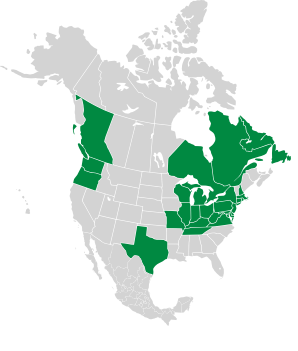Ficaria verna Huds.

|
Ranunculus ficaria L. Lesser celandine, fig buttercup, pilewort, small celandine, lesser crowfoot, dusky maiden
Lesser celandine is native to Europe and western Asia. Introduced to North America, it has become naturalized here. It prefers damp shady areas, and weedy places. It often carpets large areas. In many regions it is considered an invasive for its tendency to displace other vegetation, or because it poisons livestock. Plants: Low-growing, 4-14″ (10-35 cm) in height. It is a perennial that stores energy in numerous white finger-like tubers. Leaves: Leaves are thick, heart-shaped (cordate), spirally arranged, ¾-1½″ (1.9-3.8 cm), on long stems (petioles). Leaves are sometimes mottled with darker green patches. Flowers: Flowers are up to 1″ (2.5 cm) around, with 7-12 glossy yellow petal-like tepals, and 3 sepal-like tepals (confused yet?). They appear as early as February, or, further north, from April-May. Fruits: Achenes are spherical, up to ⅜″ (1.3 cm) around. Sometimes these are confused: |
4/8/2012 · North Central Railroad Trail, Monkton Rd, Sparks, Maryland · ≈ 1½ × 1′ (52 × 34 cm) 4/4/2011 · Oregon Ridge State Park, Timonium, Maryland · ≈ 1½ × 1′ (52 × 34 cm) 4/6/2012 · North Central Railroad Trail, Sparks, Maryland · ≈ 5 × 3½″ (13 × 9.2 cm) |
||||||||||||||||||||||||||||
|
| |||||||||||||||||||||||||||||
Stylophorum diphyllum |
You are here Ranunculus ficaria |
Chelidonium majus |
|||||||||||||||||||||||||||
|---|---|---|---|---|---|---|---|---|---|---|---|---|---|---|---|---|---|---|---|---|---|---|---|---|---|---|---|---|---|
| Common Name |  |
 |
 |
||||||||||||||||||||||||||
| Plant | Plants reach 1-1½′ (30-45 cm). Stems and leaves exude a bright yellow-orange sap when cut. | Low-growing, 4-14″ (10-35 cm) in height. It is a perennial that stores energy in numerous white finger-like tubers. | Greater celandine reaches 1½-2′ (45-60 cm) in height, with ribbed stems. Leaves contain an irritating yellow-orange sap. | ||||||||||||||||||||||||||
| Flowers | Each flower has four partially overlapping yellow petals, two sepals (which fall away early after flowering), a knobby stigma, and multiple yellow-orange stamens. They appear in groups of one to four, and are 1¼-2″ (3.2-5.7 cm) around. Flowers May-June. | Up to 1″ (2.5 cm) around, with 7-12 glossy yellow petal-like tepals, and 3 sepal-like tepals (confused yet?). They appear as early as February, or, further north, from April-May. | About ¾″ (1.9 cm) around, with four yellow non-overlapping petals, a stiff green central style, and multiple yellow stamens. | ||||||||||||||||||||||||||
| Leaves | This plant has basal leaves, as well as a pair of opposite leaves on the stem, both up to 6″ (15 cm) × 4″ (10 cm). Leaves are divided into 3-5 lobes which in turn are further divided, making them bipinnatifid. Leaf surfaces are dark green and hairless, while leaf undersides are pale as a result of fine hairs. Leaf stems (petioles) are up to 4″ (10 cm) long. | Thick, heart-shaped (cordate), spirally arranged, ¾-1½″ (1.9-3.8 cm), on long stems (petioles). Leaves are sometimes mottled with darker green patches. | Up to 8″ (20 cm) long and 3″ (7.6 cm) wide, compound in groups of 5 to 9, green with a slight bluish tint. | ||||||||||||||||||||||||||
| Fruit | Bristly blue-green ovoid seed pods ¾-1″ (1.9-2.5 cm). | Achenes are spherical, up to ⅜″ (1.3 cm) around. | Seed capsules look like thin beans, ¾-2½″ (1.9-6.3 cm) long, with black seeds. | ||||||||||||||||||||||||||
| Range/ Zones |
|
|
|
||||||||||||||||||||||||||
| Habitats | Dry deciduous woodlands, bases of bluffs, and rocky stream banks. | It prefers damp shady areas, and weedy places. It often carpets large areas. | Moist or dry woods, thickets, fields, hedgerows, roadsides, railroads | ||||||||||||||||||||||||||
| Type | Wild | Wild | Wild | ||||||||||||||||||||||||||
| Occurrence | Common | ||||||||||||||||||||||||||||
Edibility: Poisonous ![]() Toxic to people, horses, cattle,
sheep, and probably other mammals.
Toxic to people, horses, cattle,
sheep, and probably other mammals.
Online References:
References:
Clemants, Steven; Gracie, Carol, Wildflowers in the Field and Forest, Oxford University Press, 2006, p. 216
4/8/2012 · North Central Railroad Trail, Monkton Rd, Sparks, Maryland · ≈ 14 × 9″ (35 × 23 cm) 
Ficaria verna Huds.
Ranunculus ficaria description by Thomas H. Kent, last updated 25 May 2020.
© FloraFinder.org. All rights reserved.
4/4/2011 · Oregon Ridge State Park, Timonium, Maryland · ≈ 7 × 4½″ (17 × 11 cm) 
4/8/2012 · North Central Railroad Trail, Monkton Rd, Sparks, Maryland 
Range:
